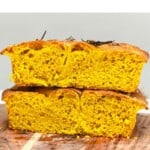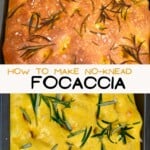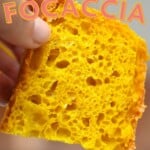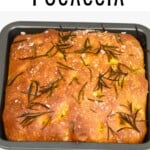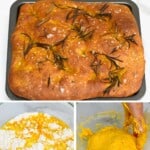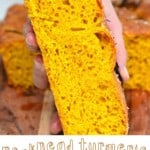This post may contain affiliate links. Please read our disclosure policy.
This turmeric rosemary no-knead focaccia bread is super simple, requires no baking skills or special equipment, and yields a flavor-packed bread with a crisp outer shell and super fluffy tender, slightly chewy crumb, and bright yellow (thanks to the turmeric) interior.
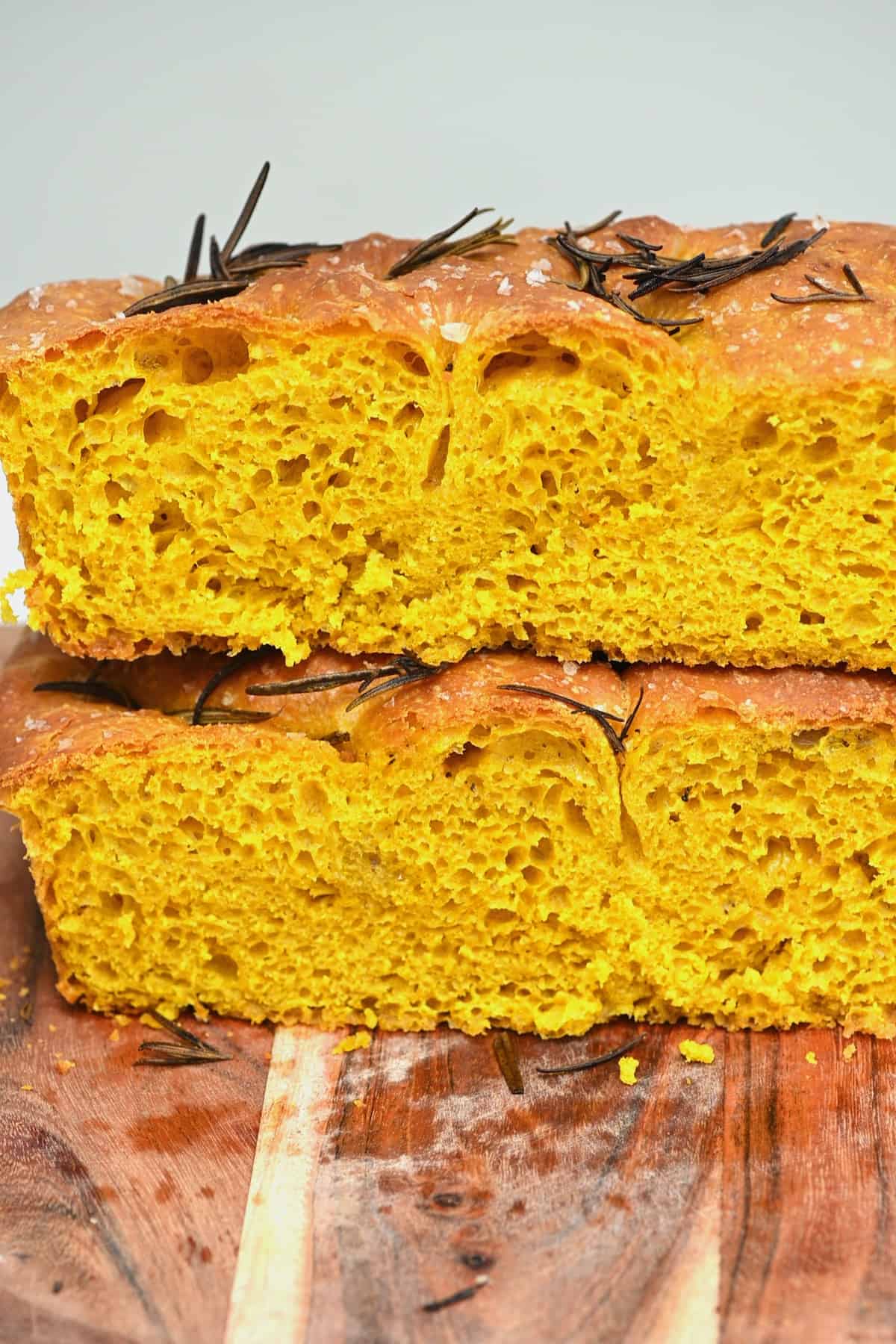
If you’re looking for a bread recipe that pretty much requires NO skill, then this turmeric rosemary no-knead focaccia is for you! As much as I’ve loved learning to make more baked goods like Greek pita, American soft pretzels, and Turkish simit (bagels), I’ve been testing focaccia recipes for months and I’m finally ready to share this easy turmeric rosemary focaccia!
For this easy rosemary focaccia, all you need is 5 ingredients and the flaky salt and rosemary toppings – plus a little patience (as this recipe relies on a slow hands-off refrigerated rise for 12hrs (up to 24hrs). This means it’s great for starting the night before, ready to bake fresh the following day!
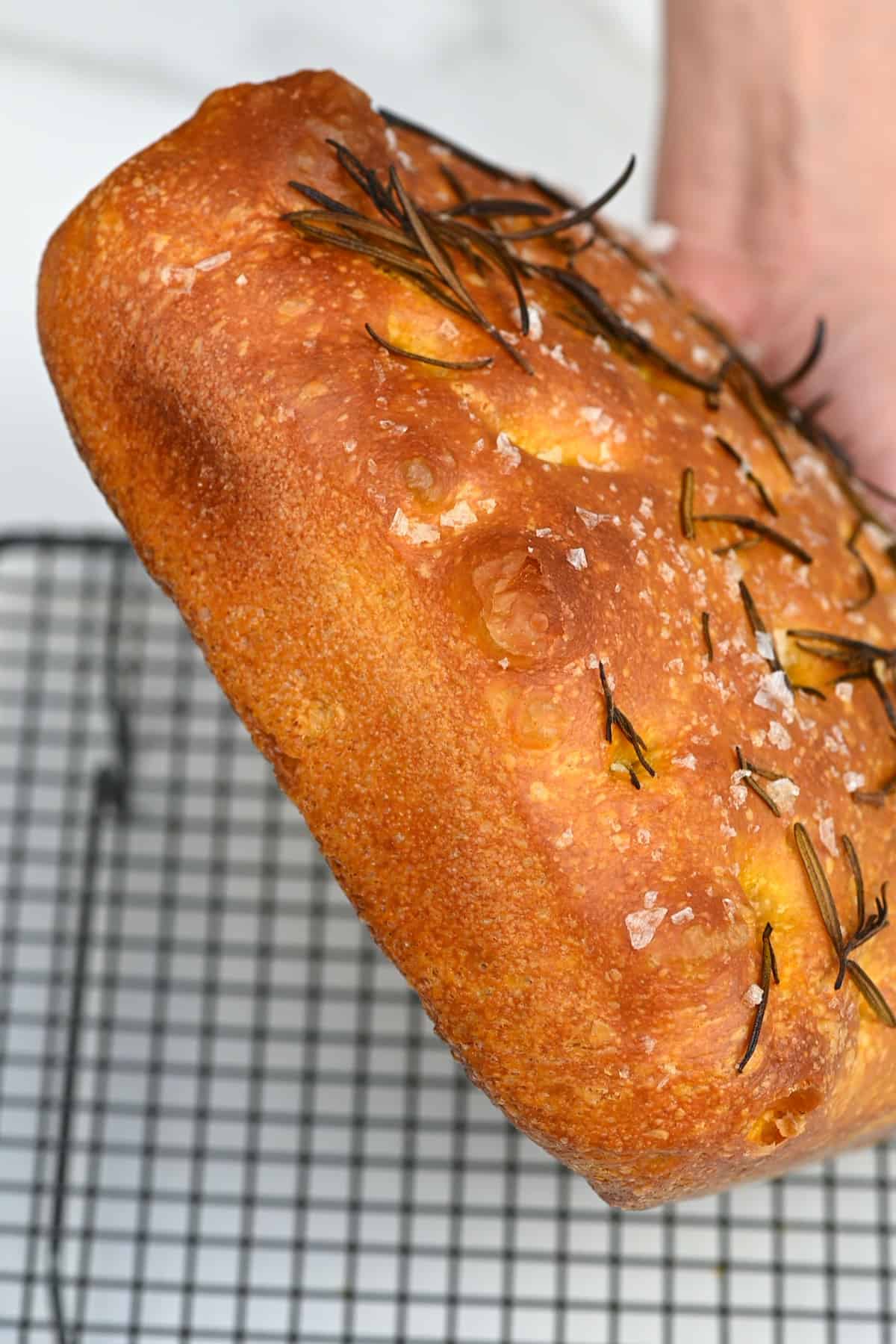
In fact, this easy focaccia bread recipe requires no stretching and folding and just minutes of hands-on prep for turmeric rosemary focaccia that tastes like it could have come fresh from an artisanal bakery but is incredibly cost-effective.
Even better, this rosemary focaccia recipe is super versatile; you can even swap out the rosemary for the toppings of your choice (suggestions below). Serve it up alone, with soups, as a flatbread pizza, or use it to up your sandwich game, you won’t regret it!
Want to save this recipe?
Table of Contents
Focaccia Ingredients
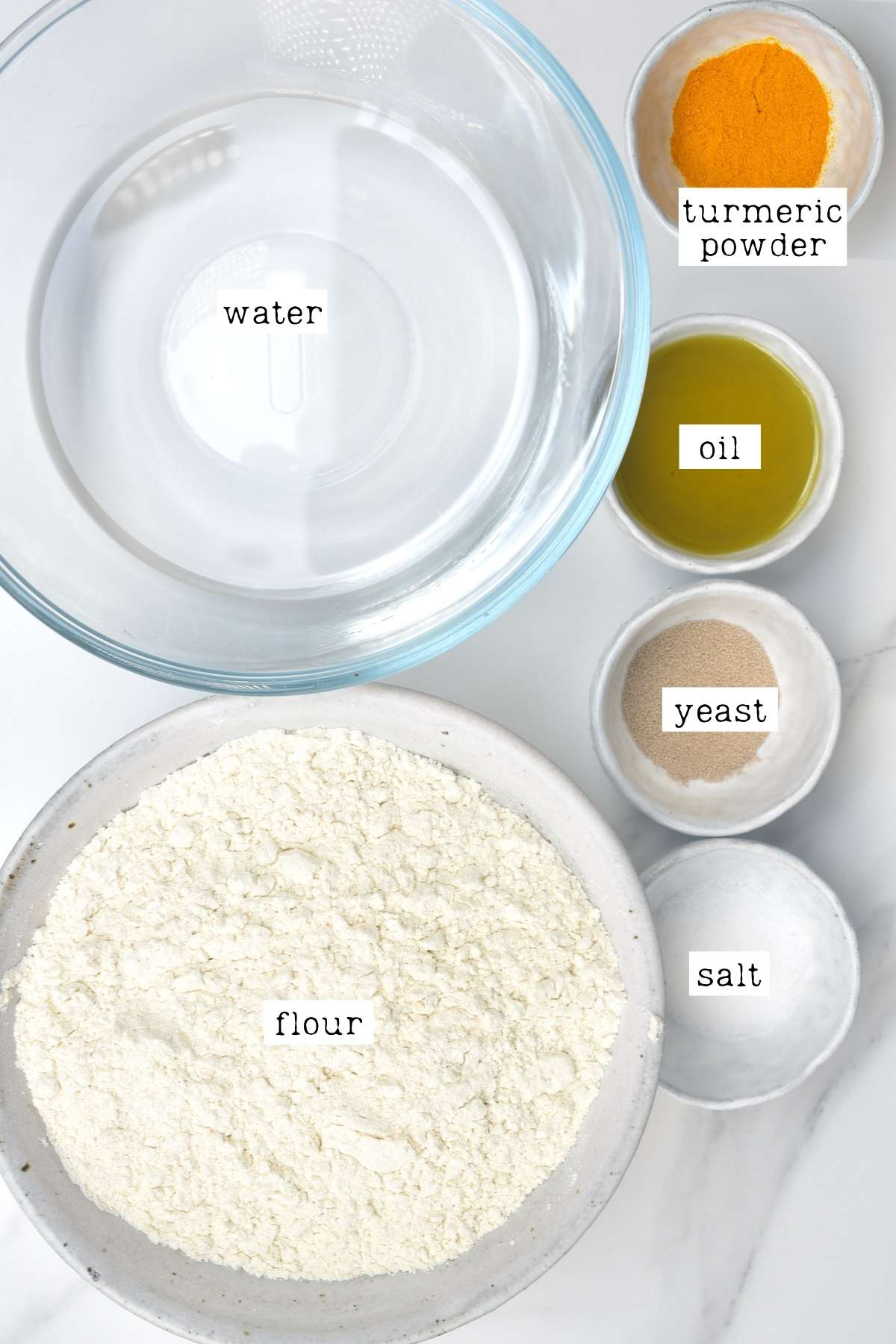
- Flour: I used strong white bread flour for this homemade focaccia bread. You could alternatively use all-purpose flour or even a 50:50 combination of the two. Bread flour contains higher protein and so yields a chewier bread. You may need to slightly adjust the amount of water used based on the flour.
- Yeast: I used active dry yeast. You could also use fresh or Instant yeast (which doesn’t even require activation and can be added straight to the dry ingredients). You can optionally add a teaspoon of sugar to help feed the yeast; however, I’ve tested with and without and found it unnecessary.
- Olive oil: it might seem like a lot of oil, but I promise it’s all needed and makes a difference. For this reason, make sure to use high-quality extra virgin olive oil – it gets absorbed into the bread, so it does a lot for the flavor.
- Water: use lukewarm water (around 100-110ºF/38-43ºC) to activate the yeast.
- Spices: turmeric powder, saffron (optional for extra color), and salt. Just note that the type of salt you use will impact how much is needed. For example, use half as much table salt as you would kosher salt.
- The toppings: flaky salt (like Maldon or homemade flaky salt) and fresh rosemary make for delicious herb focaccia. You could optionally also add some fresh minced garlic.
Optional add-ins and variations
Focaccia is known for its delicious toppings, and this no-knead focaccia is the same. For this version, I’ve used a combination of rosemary and flaky salt. However, you could swap the rosemary out for your toppings of choice, including:
- Dries spices (in dough): you can add extra flavor to the no-knead focaccia dough with dried herbs and spices: garlic powder, onion powder, Italian herbs, etc. Herb focaccia is truly delicious!
- Other toppings: sliced olives, other herbs (like thyme), parmesan, feta, sun-dried tomatoes, caramelized onions, mushrooms, peppers, jalapeno, thinly sliced potato, za’atar, Italian Seasoning, etc.
How to Make Turmeric Rosemary Focaccia Bread
Step 1: Activate the yeast
First, mix the yeast with lukewarm water and set it aside for several minutes to activate. You won’t need to do this if you’re using instant yeast.
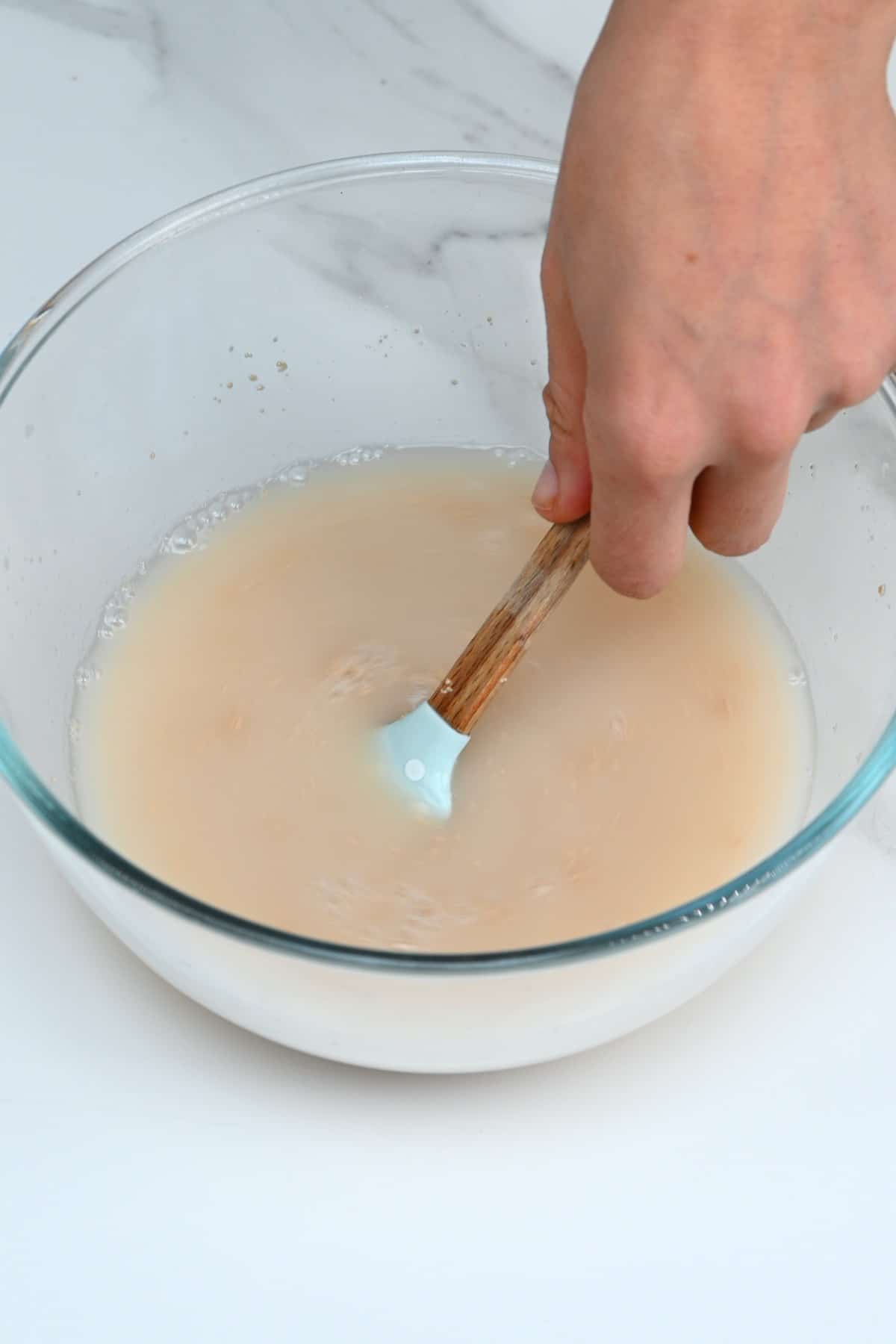
Then add the turmeric and saffron (if using) and mix well.
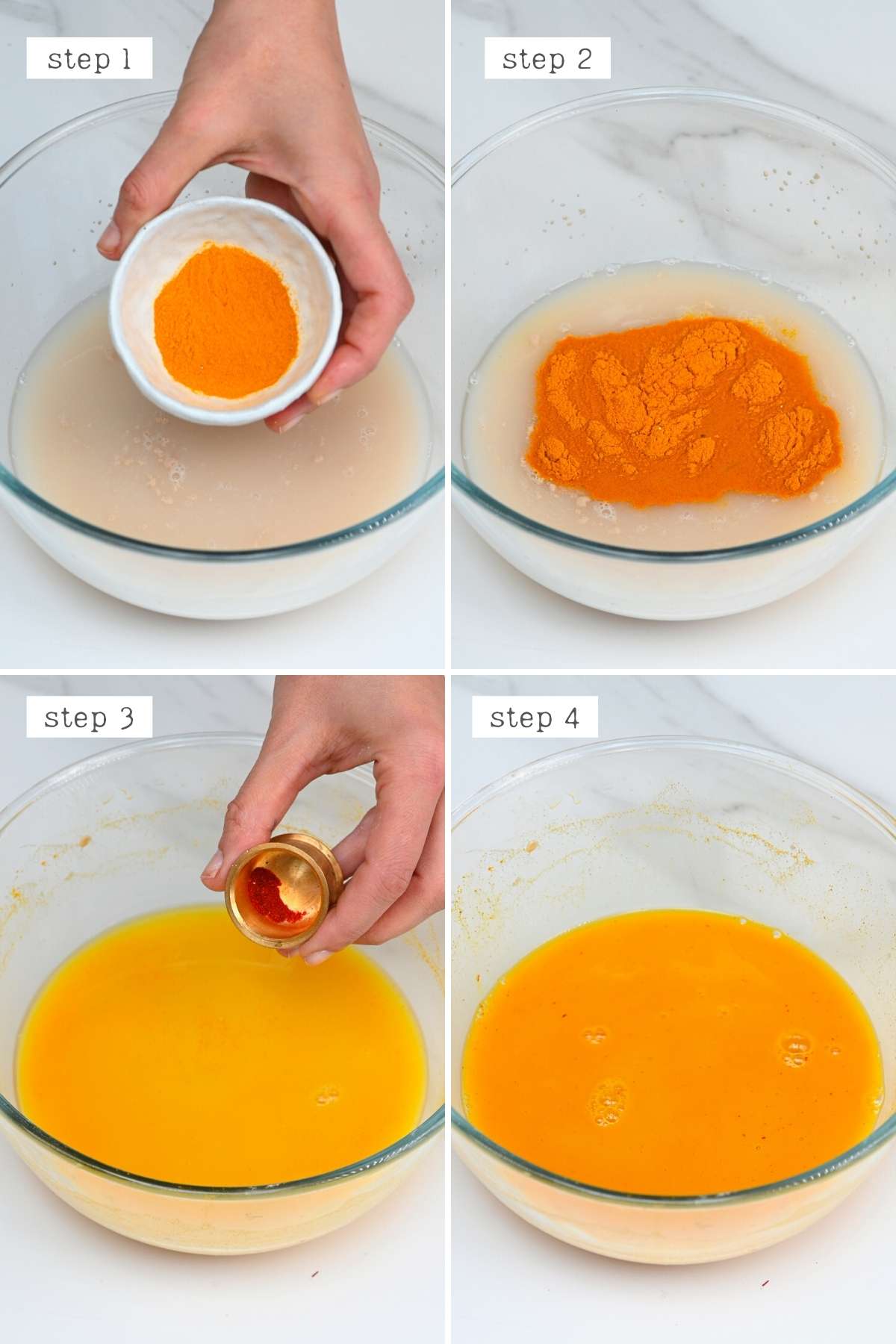
Step 2: Prepare the no-knead focaccia dough
In a separate large bowl, sift in the flour and salt. Then add the yeast mixture and mix into a shaggy dough.
Use your hands to mix it for just a couple of minutes until everything is well incorporated and it’s a tacky dough.
This no-knead focaccia dough is naturally wet and sticky – this is normal.
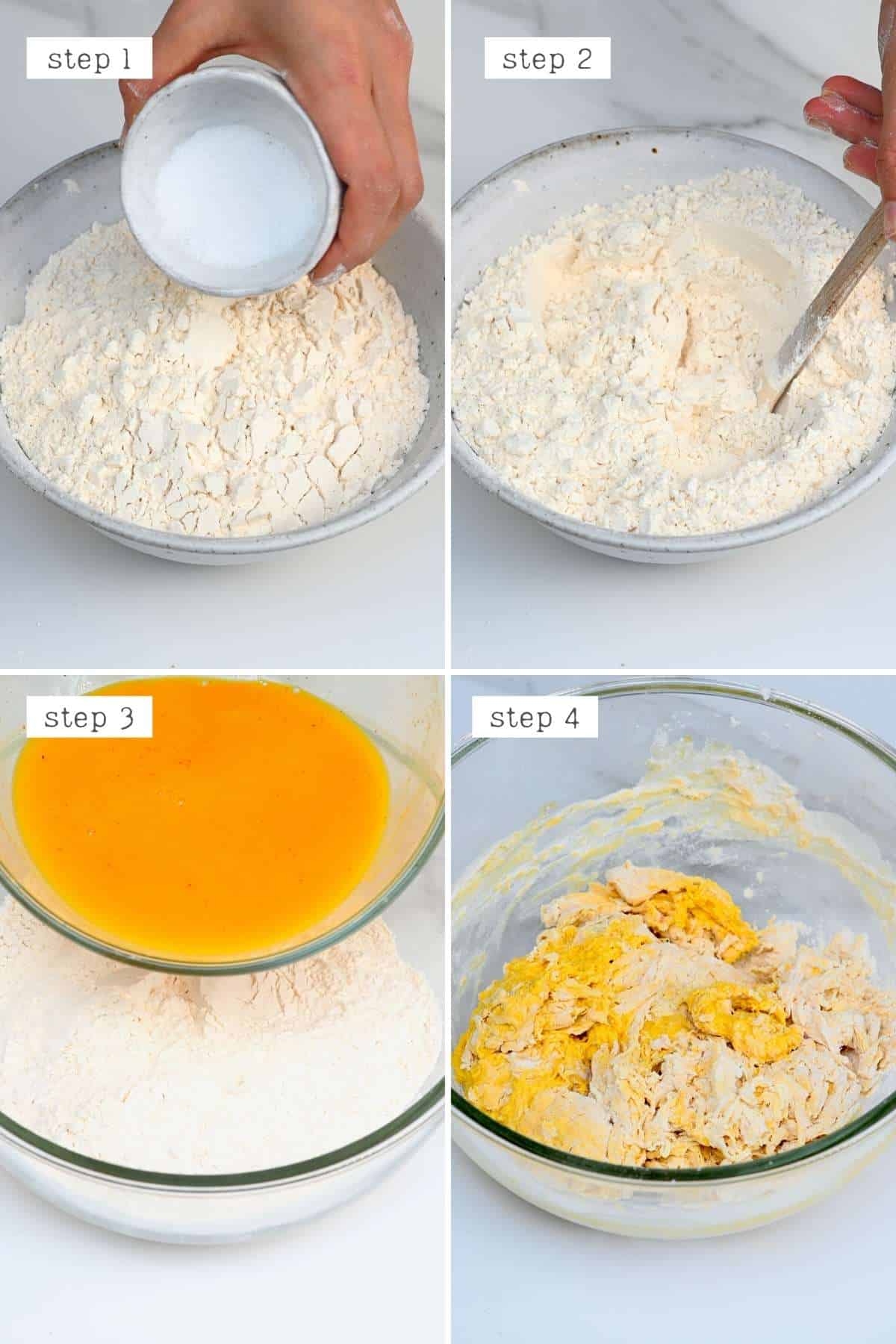
Step 3: Allow the dough to rest
Place the dough back in the bowl with half of the oil and turn the dough over slightly so it’s coated with oil on all sides.
Cover the bowl with plastic wrap and place it in the refrigerator for 12-14 hours for a slow rise.
This slow rise leads to improved texture and flavor as the ingredient ‘ferment’. You can allow it to rise for up to 24 hours.
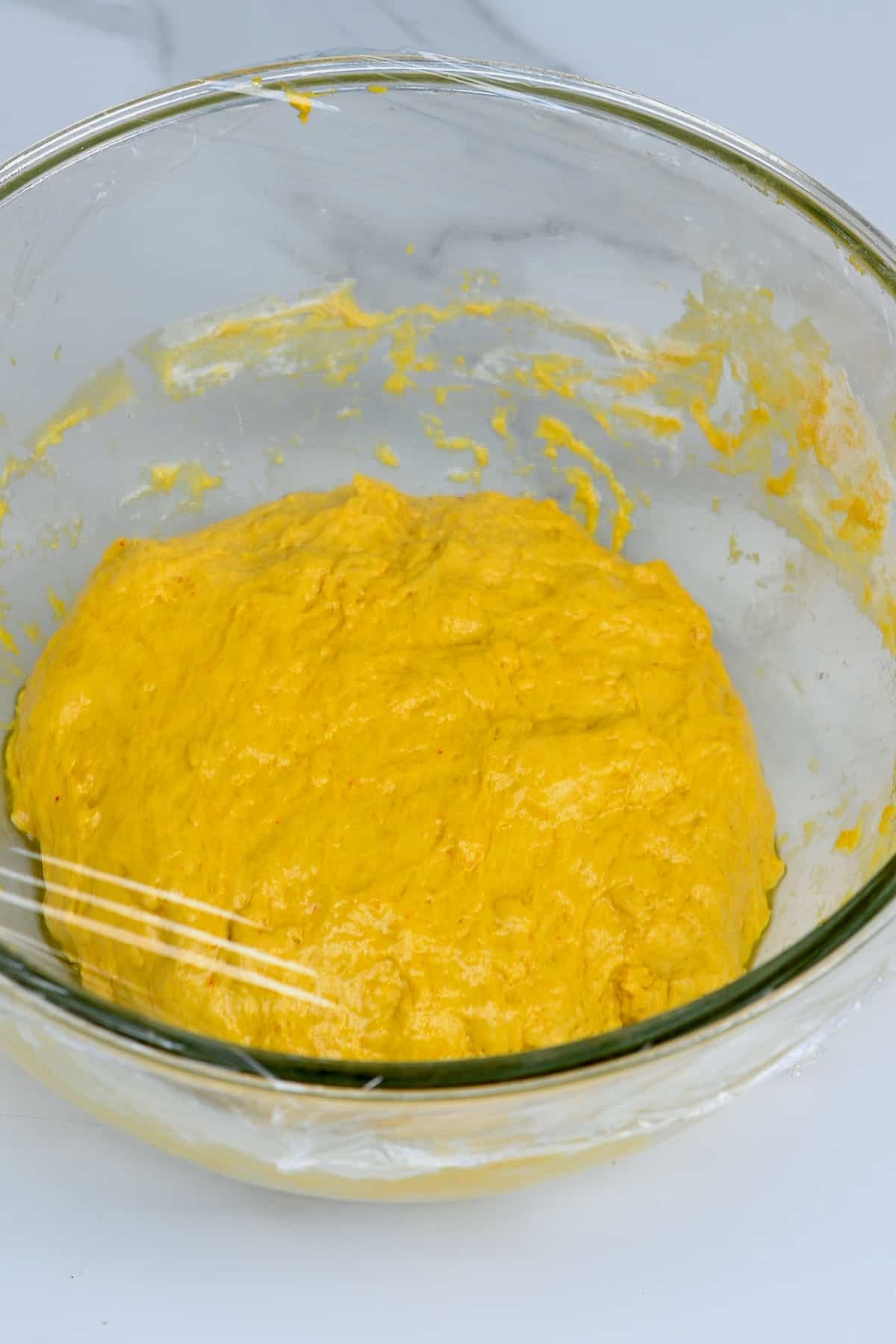
Step 4: The Second Rise
Then add the focaccia dough to a lightly oiled baking dish. I used a deep 8×11.8 inches/20x30cm non-stick metal pan for tall, thick focaccia. For thinner focaccia, you could use one that’s slightly larger (9×13 inch/23×33 cm or larger) or split the mixture between two 8×8 inch/20×20 cm pans.
Gently help it take the shape of the pan without knocking too much air from the dough, then set it aside for a further two hours for more of a rise.
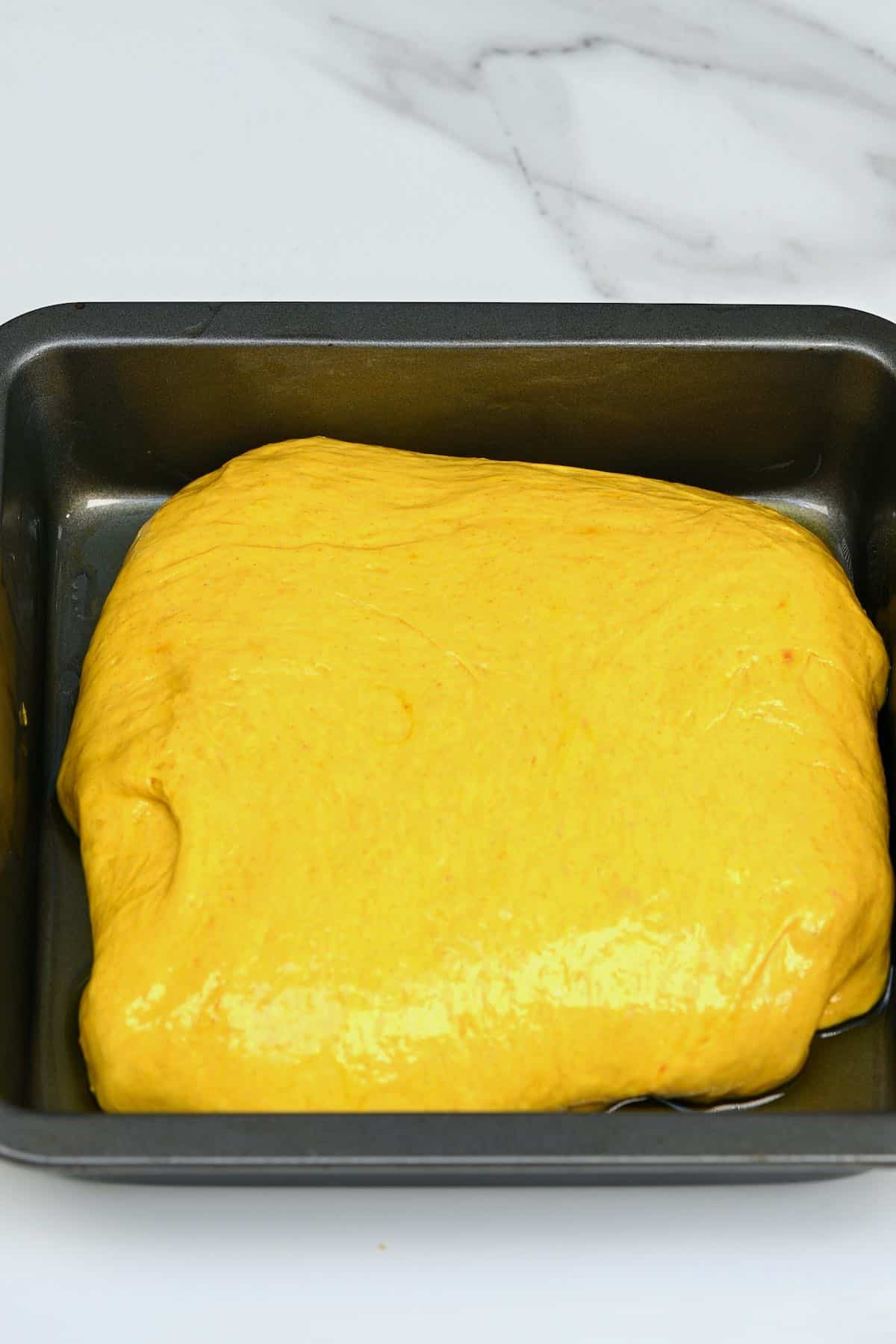
If you’re using a much larger pan, it’ll need a little extra help to spread across the tray. I recommend adding it to the pan and allow it to rest for 5 minutes, then spread it a little by dimpling it a bit, allow it to rest a further five minutes, spread again, and repeat until it’s fairly close to the edges. At that point, you can leave it to rise.
Step 5: Top and bake the turmeric rosemary focaccia
Preheat the oven to 400ºF/200ºC fan-assisted.
Top the focaccia dough with the remaining oil and use your fingers to ‘dimple’ the bread. Don’t be afraid to press right down to almost the bottom of the pan.
The dimples should remain in the dough. If they ‘spring’ back into shape then the dough isn’t ready yet and needs to rise for longer.
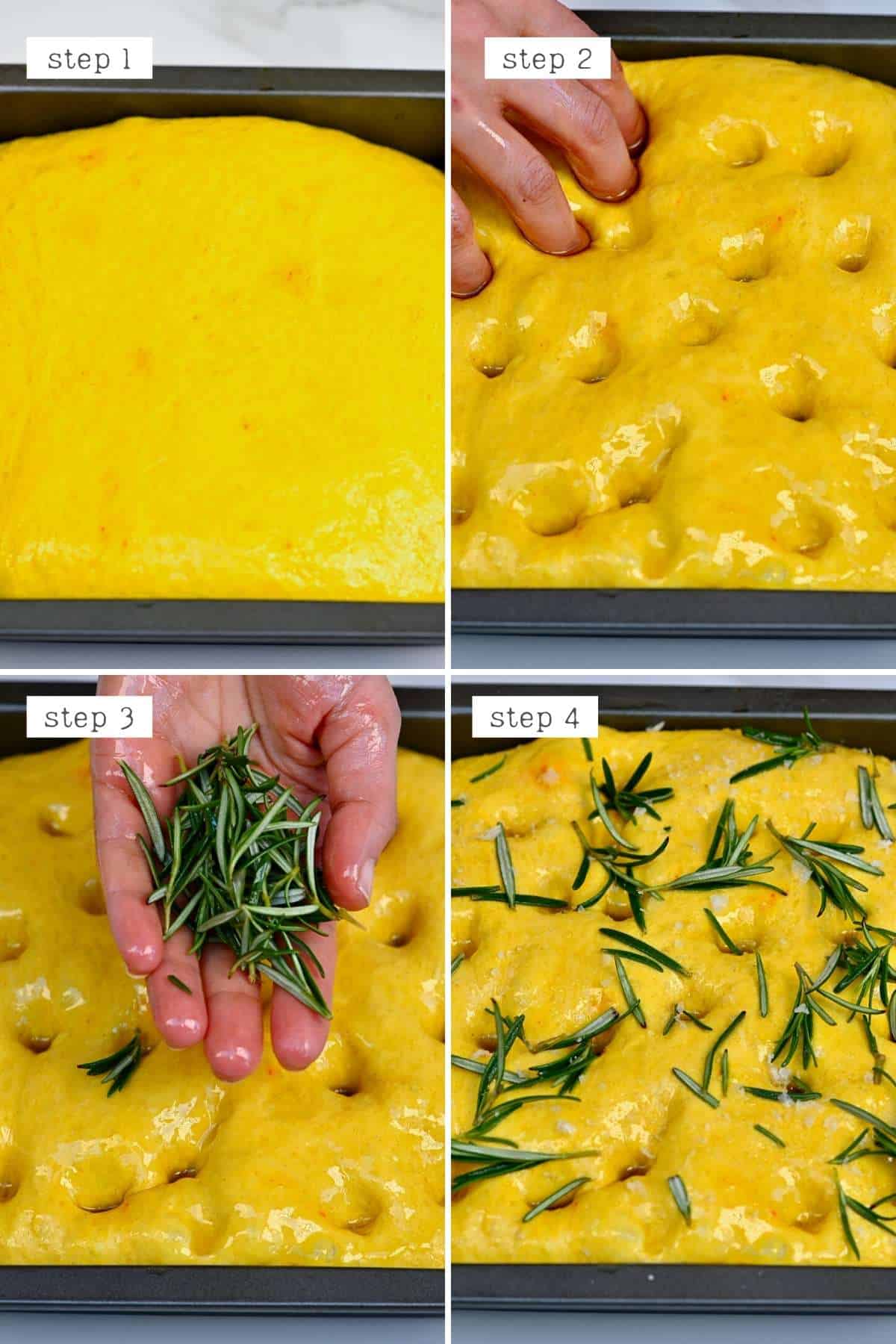
Finally, top the herb focaccia with fresh rosemary leaves and flaky salt (or the topping of your choice).
Bake the turmeric rosemary focaccia for between 40-45 minutes, or until it’s slightly puffed up and golden brown. If you’re using a wider tray then this time will be reduced slightly. I recommend checking on it at 30 minutes.
Pro tip: Place another baking tray on the shelf above the focaccia bread to prevent it from burning. You can do this right from the beginning or from around halfway if you notice it starting to brown too quickly.
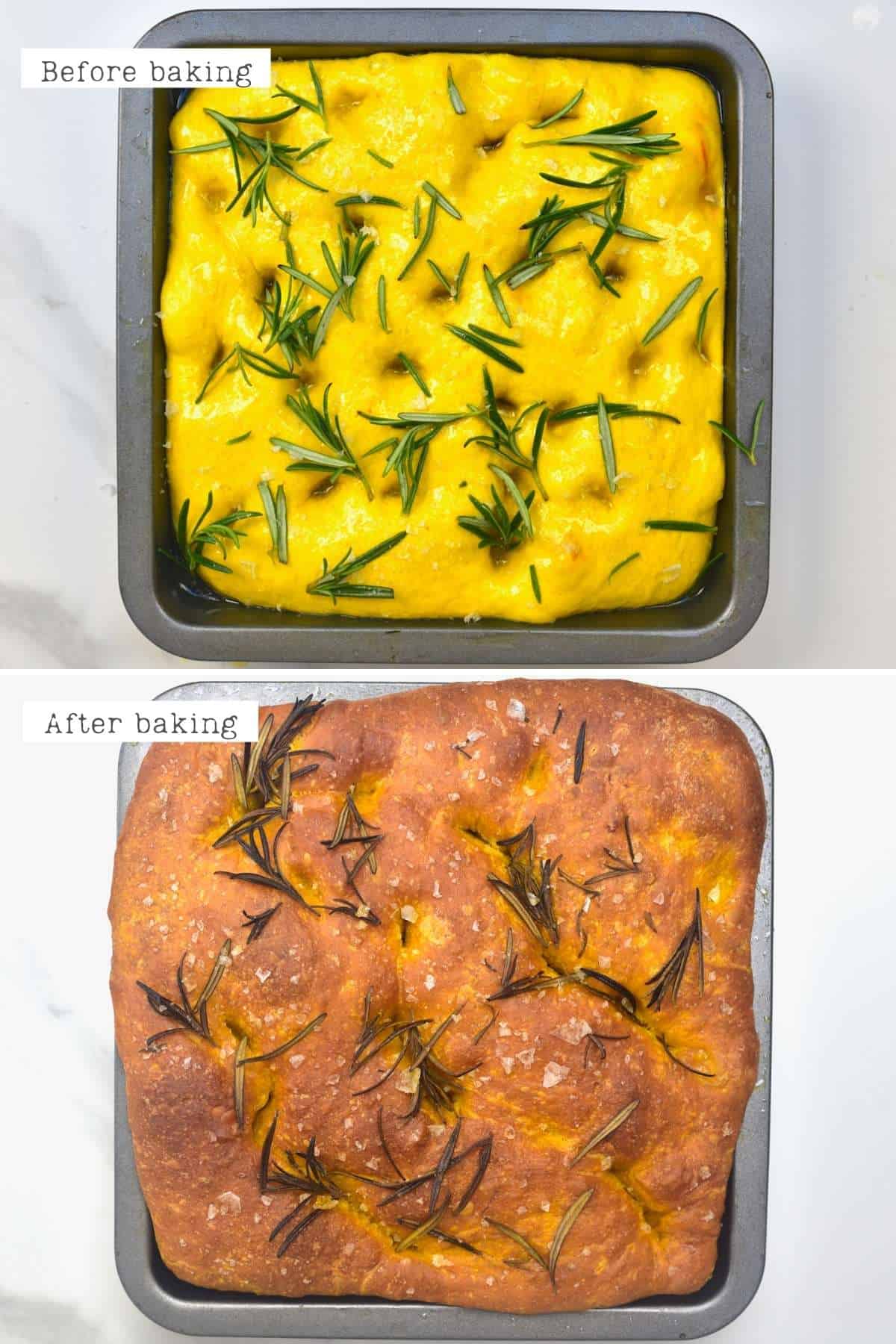
Remove it from the oven, allow it to cool slightly, and then enjoy!
How to Store Turmeric Rosemary Focaccia
Fresh focaccia tastes fantastic, especially on the day that it’s freshly baked. However, you can store it, lightly wrapped, at room temperature for 1-2 days.
Freeze: Allow the focaccia to cool, slice into individual pieces, and then spread across a baking tray, with space between them. Freeze until solid, then transfer to a freezer-safe bag/container and freeze for up to 3 months. Allow it to thaw in the refrigerator/at room temp then reheat.
Reheat: Reheat the herb focaccia in the oven at 300ºF/150ºC until warmed through (around 10 minutes, usually).
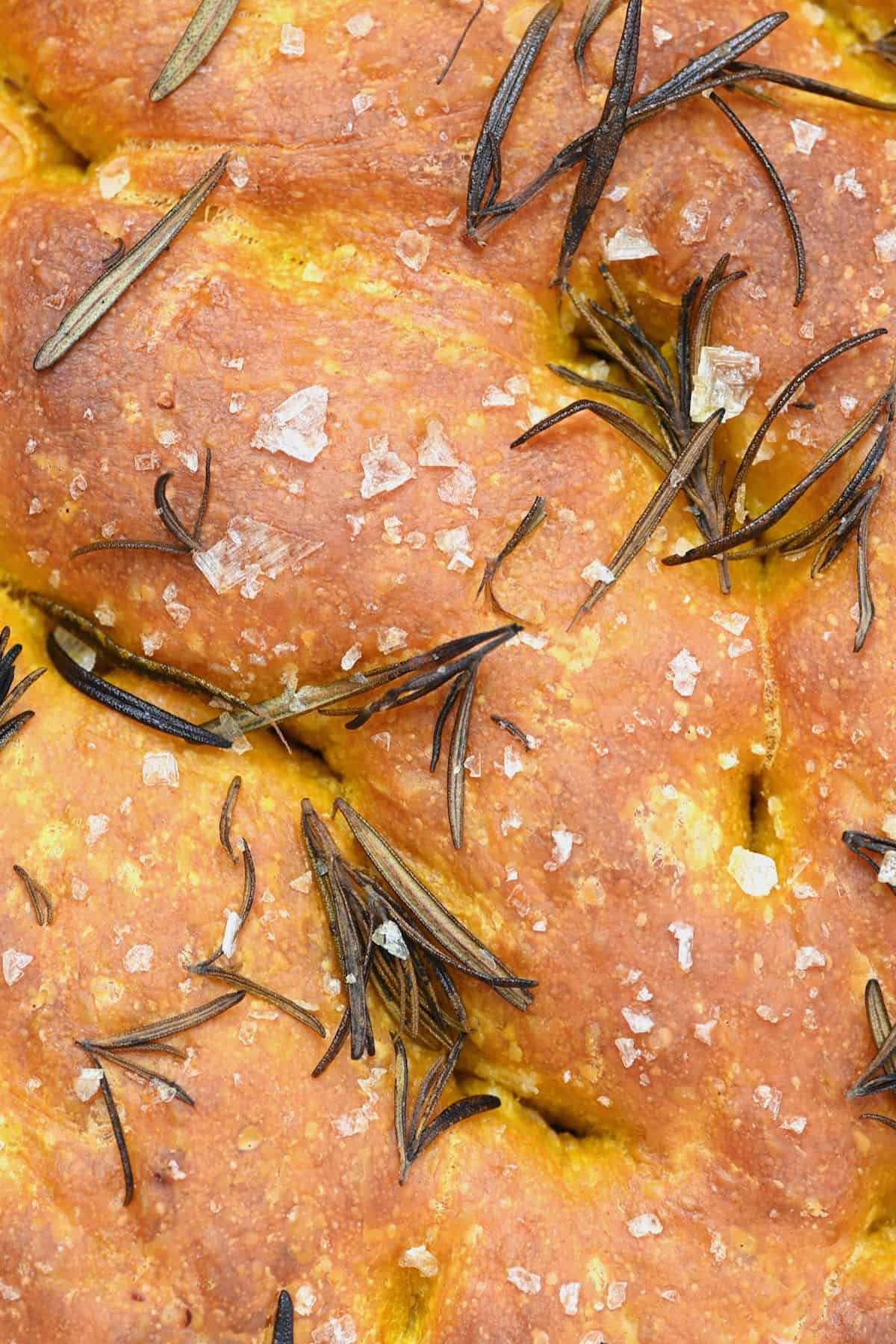
What Do You Serve With Focaccia?
If you’re anything like me, then eating a big piece of warm focaccia on its own is more than enough. However, this turmeric rosemary focaccia also makes for a great side or additions to several types of meals, including:
- Soup: like this vegan potato leek soup, creamy tomato soup, etc.
- Stews: like eggplant stew or Lebanese Green Beans (Loubieh Bi Zeit). In fact, this turmeric rosemary focaccia is perfect for dunking and sopping up saucy dishes.
- Pizza: turn this no-knead focaccia into a delicious flatbread pizza by topping with a little tomato puree, the toppings of your choice, and some cheese then broiling.
- Sandwich: up your sandwich game with this delicious turmeric rosemary focaccia bread! Or enjoy a sweet snack by topping the focaccia with some dandelion honey.
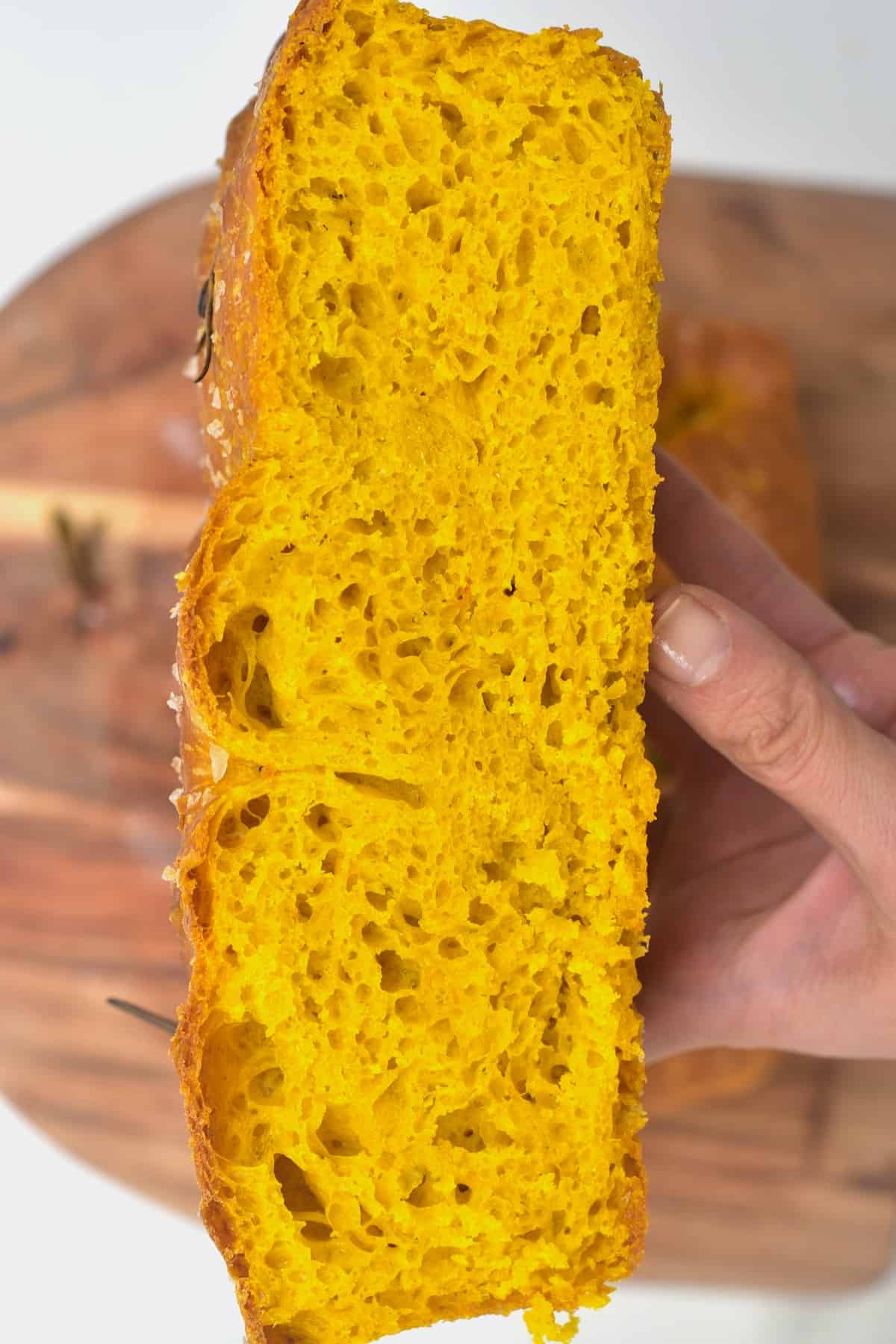
FAQs
This provides the homemade focaccia bread with texture and stops it from rising too much as it bakes.
It’s critical to make sure to thoroughly oil (or butter and oil) the pan. I also recommend using a non-stick metal pan too. Avoid using glass pans, as it’s more likely to stick (plus they don’t conduct heat as well either).
You can place the no-knead focaccia dough in the fridge (once more) to slow down the rising. If it’s almost ready, I wouldn’t do this for more than 3-4 hours.
Unlike regular bread, which requires kneading to stretch and develop the gluten stands within the dough, this no-knead focaccia is best prepared with a long overnight fermentation. During this time, enzymes within the dough break down the gluten, mimicking the kneading process (without lifting a finger). It will also fill with gases to provide the light, fluffy texture.
You sure can. However, don’t substitute it all, as the bread can become dense – not what we want from homemade focaccia. Instead, I recommend using up to 40% wholewheat – 50% at a stretch. Just note that you may need more water, as whole wheat flour is more absorbent.
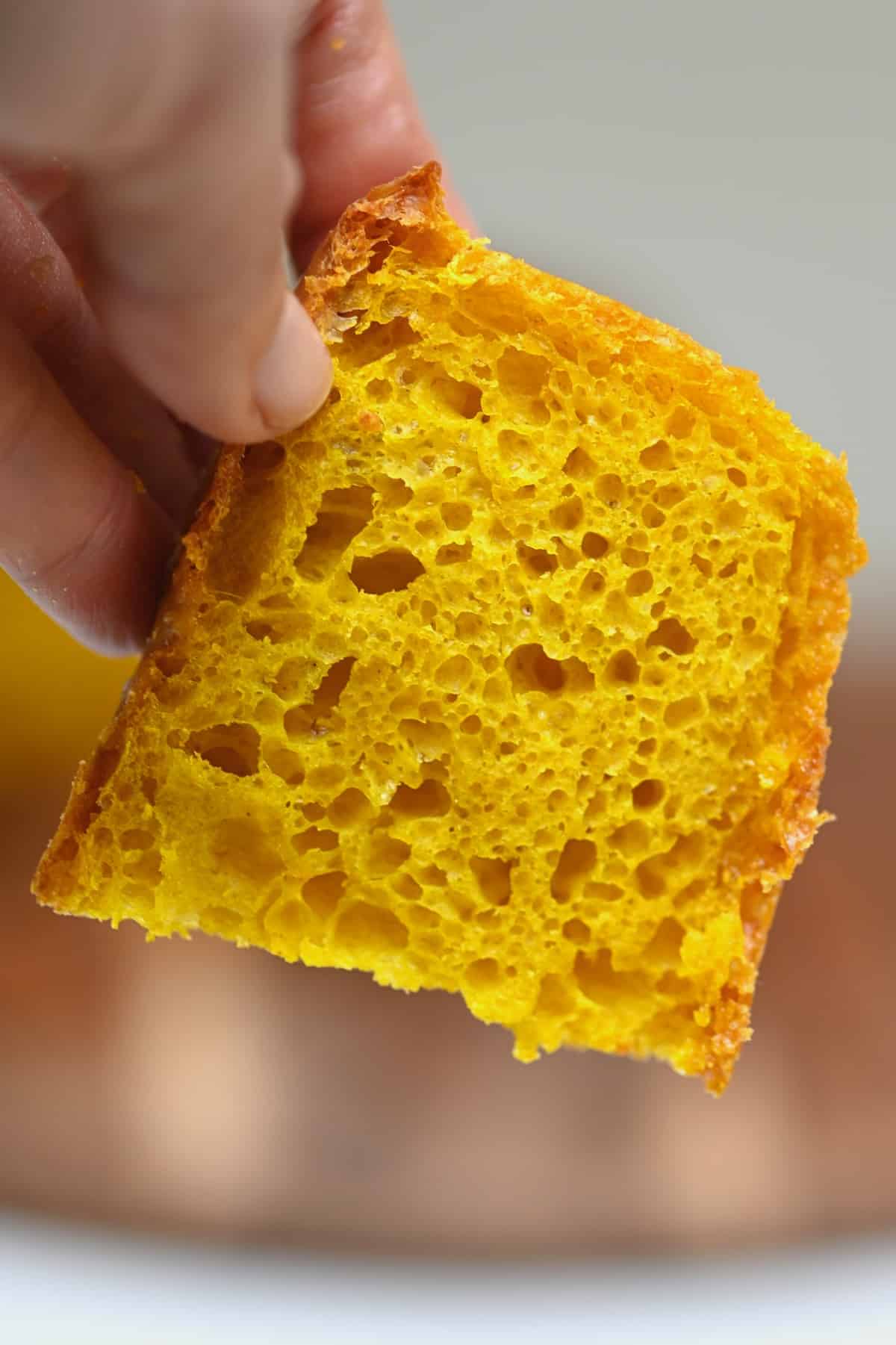
Recipe Notes & Variations
- Test your yeast: one of the most significant issues people have when making homemade bread is using ‘dead’ yeast. To test it, combine some yeast with the lukewarm water and a little sugar and leave to activate for a few minutes – if it foams up, use it. If not – you need new yeast. Just remember If you use instant yeast, there’s no need to activate the yeast. Just make sure, if you’re using anything other than active dry yeast, to convert it to the correct amount.
- Using garlic: if you want to add garlic to your focaccia, it’s best to add this in the last 5 minutes of the baking time, so the garlic doesn’t burn. You could also create a melted butter and garlic mixture to brush over the baked focaccia.
- Using a larger pan: if you want to make thin focaccia and decide to use a far larger pan, make sure to check on it after 30 minutes of baking.
- The wet dough: this is a high humidity dough that is very wet and sticky. Unlike many bread recipes, it doesn’t need to hold its own shape for a deliciously fluffy, light rosemary focaccia.
- Omit the turmeric: this ingredient makes for a gorgeously yellow-colored homemade focaccia, but is optional too!
More Bread Recipes
- Homemade New York-Style Bagels (NY Bagel Recipe)
- Easy No-Knead Turkish Bread (Ramadan Pide Bread)
- Easy Cheese Flatbread (Cheese Manakish)
- Zaatar Bread (Manakish Za’atar)
- The Best Authentic Homemade Pita Bread
- Homemade Garlic Naan Bread (Indian Flatbread)
- Authentic Corn Tortilla Recipe (Gluten-Free Tortillas
If you try this turmeric rosemary no-knead focaccia recipe, I’d love to hear your thoughts/questions below. Also, I’d appreciate a recipe card rating below, and feel free to tag me in your recipe recreations on Instagram @Alphafoodie!
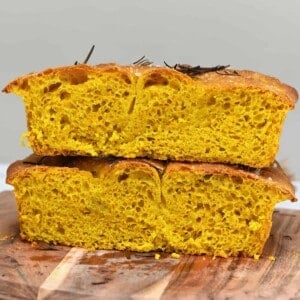
Easy Turmeric Rosemary No-Knead Focaccia Bread
Ingredients
- 18 ounces strong white bread flour or AP flour, 50/50 AP and bread, or even using up to 40% whole wheat with the bread flour/AP
- 1.5 tsp dry yeast 10g/0.35 oz
- 1.5 tsp salt
- 1/3 cup olive oil etra virgin
- 1.5 cup water
- 1/2 Tbsp ground turmeric powder you can omit if preferred
- saffron optional
Toppings
- fresh rosemary
- salt flakes
Instructions
Step 1: Activate the yeast
- Mix the yeast with lukewarm water and set it aside for several minutes to activate. You won’t need to do this if you’re using instant yeast.
- Add the turmeric and saffron (if using) and mix well.
Step 2: Prepare the no-knead focaccia dough
- In a separate large bowl, sift in the flour and salt. Then add the yeast mixture and mix into a shaggy dough.
- Use your hands to mix it for just a couple of minutes until everything is well incorporated and it’s a tacky dough.This no-knead focaccia dough is naturally wet and sticky – this is normal.
Step 3: Allow the dough to rest
- Place the dough back in the bowl with half of the oil and turn the dough over slightly so it’s coated with oil on all sides.
- Cover the bowl with plastic wrap and place it in the refrigerator for 12-14 hours for a slow rise.This slow rise leads to improved texture and flavor as the ingredient ‘ferment’. You can allow it to rise for up to 24 hours.
Step 4: The Second Rise
- Add the focaccia dough to a lightly oiled baking dish. I used a deep 8×11.8 inches/20x30cm non-stick metal pan for tall, thick focaccia. For thinner focaccia, you could use one that’s slightly larger (9×13 inch/23×33 cm or larger) or split the mixture between two 8×8 inch/20×20 cm pans.
- Gently help it take the shape of the pan without knocking too much air from the dough, then set it aside for a further two hours for more of a rise.If you’re using a much larger pan, it’ll need a little extra help to spread across the tray. I recommend adding it to the pan and allow it to rest for 5 minutes, then spread it a little by dimpling it a bit, allow it to rest a further five minutes, spread again, and repeat until it’s fairly close to the edges. At that point, you can leave it to rise.
Step 5: Top and bake the turmeric rosemary focaccia
- Preheat the oven to 400ºF/200ºC fan-assisted.
- Top the focaccia dough with the remaining oil and use your fingers to ‘dimple’ the bread. Don’t be afraid to press right down to almost the bottom of the pan.The dimples should remain in the dough. If they ‘spring’ back into shape then the dough isn’t ready yet and needs to rise for longer.
- Top the herb focaccia with fresh rosemary leaves and flaky salt (or the topping of your choice).
- Bake the focaccia for between 40-45 minutes, or until it’s slightly puffed up and golden brown. If you’re using a wider tray then this time will be reduced slightly. I recommend checking on it at 30 minutes.Pro tip: Place another baking tray on the shelf above the focaccia bread to prevent it from burning. You can do this right from the beginning or from around halfway if you notice it starting to brown too quickly.
- Remove it from the oven, allow it to cool slightly, and then enjoy!
How to Store Turmeric Rosemary Focaccia
- Fresh focaccia tastes fantastic, especially on the day that it’s freshly baked. However, you can store it, lightly wrapped, at room temperature for 1-2 days.Freeze: Allow the focaccia to cool, slice into individual pieces, and then spread across a baking tray, with space between them. Freeze until solid, then transfer to a freezer-safe bag/container and freeze for up to 3 months. Allow it to thaw in the refrigerator/at room temp then reheat.Reheat: Reheat the herb focaccia in the oven at 300ºF/150ºC until warmed through (around 10 minutes, usually).
Notes
- Test your yeast: One of the most significant issues people have when making homemade bread is using ‘dead’ yeast. To test it, combine some yeast with the lukewarm water and a little sugar and leave to activate for a few minutes – if it foams up, use it. If not – you need new yeast. Just remember If you use instant yeast, there’s no need to activate the yeast. Just make sure, if you’re using anything other than active dry yeast, to convert it to the correct amount.
- Using garlic: If you want to add garlic to your focaccia, it’s best to add this in the last 5 minutes of the baking time, so the garlic doesn’t burn. You could also create a melted butter and garlic mixture to brush over the baked focaccia.
- Using a larger pan: If you want to make thin focaccia and decide to use a far larger pan, make sure to check on it after 30 minutes of baking.
- The wet dough: This is a high humidity dough that is very wet and sticky. Unlike many bread recipes, it doesn’t need to hold its’ own for a deliciously fluffy, light rosemary focaccia.
Optional add-ins and variations: Focaccia is known for its’ delicious topping, and this no-knead focaccia is the same. For this version, I’ve used a combination of rosemary and flaky salt. However, you could swap the rosemary out for your toppings of choice, including
- Dries spices (in dough): You can add extra flavor to the no-knead focaccia dough with dried herbs and spices; garlic powder, onion powder, Italian herbs, etc. Herb focaccia is truly delicious!
- Other toppings: Sliced olives, other herbs (like thyme), parmesan, feta, sun-dried tomatoes, caramelized onions, mushrooms, peppers, jalapeno, thinly sliced potato, za’atar, Italian Seasoning, etc.
Read the FAQs for tons more answers!
Nutrition
Nutrition information is automatically calculated, so should only be used as an approximation.

